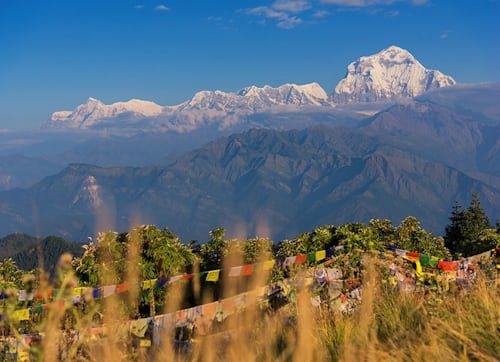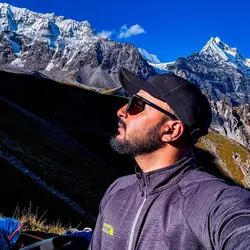
8 Days Ghorepani Poon Hill Trek
- Airport Pickup and Drop off
- Porter Arrangements
- Fluent English Speaking Trek Guide
- Free cancellation if informed 30 days prior
Nepali/SAARC residents, please contact our team for your price. Rates may vary due to permit and tax requirements.
Talk to our Expert





Tour Highlights
What makes this tour special
The Ghorepani Poon Hill Trek is an 8-day adventure at Nepal’s great Annapurna side, beginning through the vibrant city of Pokhara. This trek is also taken from explorers at the enchanting full rhododendron forests and fines Gurung and Magar villages, following the ancient trade route for route for a glimpse at the local life. The highlight is the ascent at the Poon Hill, famed for several sunrise views of Annapurna and Dhaulagiri mountain ranges, where trekkers can enjoy the great peaks such as Annapurna South, Hiunchuli, Nilgiri as well as Machhapuchhre.
Perfect trekking seasons are spring (March to May) and autumn (September to November), when the weather is also very stable, with clear blue skies and several temperatures. These conditions have allowed aspiring trekkers to appreciate landscapes and rich cultural interactions in the local communities. Nights spent at comfortable tea houses have also offered great meals and opportunities for storytelling with several trekkers, making the Ghorepani Poon Hill Trek a great mix of natural beauty and cultural immersion for trekkers for all levels.
Itinerary
A day-by-day guide to your journey
Arrival in Pokhara
Please arrive at the great city of Pokhara, which is celebrated for its great lakes and fine mountain scenery. Take the day to wander through the grand streets and see the local gems, including the calm Phewa Lake, where you can also enjoy boats or relax on the shore. Take advantage of a visit to the Peace Pagoda, which gives excellent views of the incredible landscape and is a fine spot for reflection.
After a day of exploration, settle at your hotel for a restful night. This fine city, with its welcoming atmosphere and incredible cultural experiences, is the beginning point of your trekking adventure. Enjoy the journey ahead as you reach lovely Pokhara and its refined surroundings.
Drive to Nayapul and Trek to Tikhedhunga
After breakfast, set off on the incredible drive to Nayapul, which takes around 1.5 hours? From Nayapul, start your trek to Tikhedhunga, where you will pass through well-trodden fields and fine villages. This gentle hike segment allows you to soak up the green landscape.
The trek at the Tikhedhunga typically takes 4-5 hours, giving plenty of chances to interact with the local villagers and experience their way of life. As you reach Tikhedhunga, settle for the night through the comfortable tea house, where you can rest and see stories with several trekkers after a great day of exploration.
Tikhedhunga to Ghorepani
Get to leave the wonderful Tikhedhunga behind and begin the challenging ascent at the Ghorepani, a journey that has around 6-7 hours. The trail goes to the great rhododendron forests, where you can also see through the colorful blooms and listen to the sounds of nature. Along the way, watch for fine views of the fine mountains, adding to the region's trio's magic.
Upon arriving at Ghorepani, take a moment and soak in the great atmosphere and breathtaking scenery. Settle into the local tea house at night, where you can also relax upon the day's journey. This charming village works as an excellent base for the next day's adventure around Poon Hill.
Sunrise at Poon Hill and Trek to Tadapani
Get up early and go on a short hike at Poon Hill to experience the delicate sunrise light up at the Annapurna region. As the first light breaks turns at the peaks, you will be treated to the breathtaking vistas, which will make the fine wake-up call genuinely great. This significant moment provides a fine backdrop for the reflection and photography.
After going at the views, return to the Ghorepani for a great breakfast and charge at your next leg for the journey. Begin your trek at Tadapani, which will take 6-7 hours. The trail is rich in natural beauty, going through the en forests and old villages, giving an excellent opportunity to engage the communities.
Tadapani to Ghandruk
Through Tadapani, set on a trek to the lovely village of Ghandruk, a journey that takes around 4-5 hours. Enjoy the great scenes and observe the refined local culture as you walk on. Ghandruk is well known for its age-old Gurung heritage, which provides an extraordinary glimpse into villagers' daily lives.
Upon arriving at the Ghandruk, take some time to admire the great views of Annapurna South and Machhapuchhre. Spend the full night at the comfortable tea house, where you can sample the local cuisine and rest after your trek.
Ghandruk to Nayapul and Drive Back to Pokhara
Upon breakfast, start your trek back to Nayapul, which takes 4-5 hours. As you move through the scenic landscape, take in the beauty of the surroundings one last time before reaching the destination, Nayapul.
Once you arrive, drive back to Pokhara and enjoy some free time there. This is the perfect opportunity to savour delicious local cuisine or explore the fine markets for souvenirs.
Rest Day in Pokhara
Take the great day and rest at Pokhara, a city filled with many activities. Consider getting to rent a boat at Phewa Lake, where you can also see all across the cool waters and enjoy the great views for the nearby mountains. For the adventurous sort, paragliding is the best way to experience from the landscape from all above, giving the best perspective to see the lovely scenery.
In addition at these activities, explore at the local markets, where you can also shop for handicrafts and souvenirs or take tasty Nepali cuisine at one of many restaurants. If you're up for it, another day hikes in the close viewpoints will allow you at the discover even more than Pokhara’s great beauty.
Departure from Pokhara
As your adventure ends, you can also fly or drive at the Pokhara at your next destination for your travel plans. This journey gives you one very final chance to go at the great landscapes for the Nepal, allowing you to reflect at the fine experiences you've had.
Carry with you at the unforgettable memories for the Ghorepani Poon Hill Trek, through the breathtaking sunrises at the rich cultural encounters. The beauty at the Annapurna region will stay with you long after you have finished , inspiring you to share your greats stories and plan at your next Himalayan outings.
Availability
Contact us for any Inquiries
Included & Excluded
What's covered in this package
- Pick up and drop off from and to international airport.
- 2-nights of 3-star standard hotel rooms in Kathmandu, including breakfast.
- Two nights of hotel accommodation in Pokhara, including breakfast.
- During the walk, you will stay in local lodges for three nights.
- An experienced and government-certified guide for the treks.
- During the walk, three meals are provided each day. (breakfast, lunch, supper)
- Ground transportation from Kathmandu to Pokhara and back are provided by a luxury tourist bus.
- Transfers from Pokhara to Nayapul and Ghandruk to Pokhara are via private vehicle.
- All trekking permits and documentation for the trek.
- For the trek, a rain protection duffel bag and a sleeping bag.
- First aid supplies for the treks.
- A trip achievement certificate after completion of the trek
- All government taxes and company service fees
- Farewell Dinner at the end of the trip
Good To Know
Important information for travelers
Physical fitness: Long days of trekking over a variety of terrain, including steep ascents and descents at high altitudes, are a requirement of the Ghorepani Poon Hill Trekking. It is suggested to prepare physically beforehand by engaging in strength and cardiovascular training.
Altitude Considerations: Although the Ghorepani Poon Hill trek's highest height is not particularly high in comparison to other Nepalese treks, altitude-related complications might still arise. It is critical to be aware of the signs of altitude sickness and acclimate properly along the route.
Packing Essentials: Pack clothing appropriate for the weather, including warm layers for chilly mornings and evenings, as well as rain gear for potential showers. Comfortable trekking shoes with a strong grip are also required, as is a day pack to carry necessities such as water, snacks, and sunscreen.
Permits & Documentation: Make sure you have all of the required permits for the trek, including the Annapurna Conservation Area Permit (ACAP) and the Trekkers' Information Management System (TIMS) card. These permits are normally available through your hiking agency or upon arrival in Pokhara.
Hydration and Nutrition: Staying hydrated and well-nourished is essential during the hike. Carry plenty of water and snacks, and consider carrying electrolyte-replenishing drinks or tablets to avoid dehydration. Additionally, aim to consume balanced meals to keep your energy levels up throughout the walk.
Trekking itinerary: Get acquainted with the trekking schedule, which includes daily distances, elevation increases, and predicted walking times. A thorough awareness of the route and itinerary will help you psychologically and physically prepare for each day's walk.
